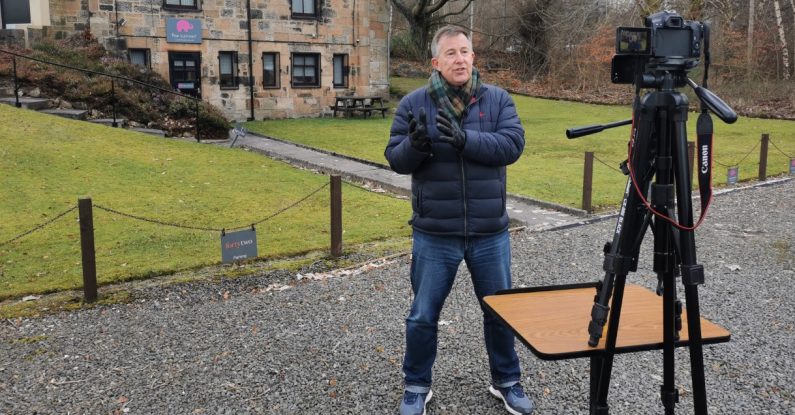
One of the most common questions we’re asked is how to stand when presenting.
It can feel awkward to begin with.
Do I stay rooted to the spot?
Is it better to take steps from side to side?
And what should my hands be doing?
Read on for three steps you can take to ensure you’re in the best possible position.
So let’s presume you’re preparing to present in an everyday setting.
Speaking to a room of expectant faces.
Or pitching for business to a smaller group.
The first thing you must do is plant your feet.
What do we mean by that?
Imagine your feet are set in concrete.
Or even better, imagine you’re unable to move from the hips down.
This gives you a steady base to start with and stops any distracting swaying.
It’s one of the first casualties of nervous presenters.
A shifting of bodyweight from one foot to the other.
Audiences notice, and see it as a sign of the presenter’s discomfort.
Often, people are only aware they’re swaying when they watch a recording of themselves.
So start there.
Record yourself giving a presentation, either as a practice or for real.
Observe what your body language is telling the audience.
And, from now on, start with your feet rooted to the spot.
You’ve begun your presentation from a solid base.
And now you’ve got a choice.
Are you a walker or a stander?
By that I mean: do you want to walk around the space you have?
Or would you prefer to stay where you are?
There’s a couple of issues to consider.
If you’re limited to a small room or presenting in front of a table, standing may be your only option.
But if you feel comfortable and have the space to do so, take purposeful steps as you present.
Make sure they’re purposeful though.
Often the nerves can mean our steps become shuffles.
Using a clicker to continue any PowerPoint you have frees you to walk away from the computer, too.
And while we’re on the subject, it’s worth reading how best to use slides to increase their impact.
And in the process grow your own confidence as a presenter.
Dealing with your feet is the first step (if you’ll pardon the pun).
The second aspect is what to do with your hands.
In the photo above, Andrew’s demonstrating what we call speaker’s stance.
Hands together in a central position.
And then, as you present, you can become animated.
As Andrew demonstrates here.
Your hands will then naturally return to the central position they started in.
Here are a few more tips.
Leave any clicky pens behind as they can be very distracting in nervous fingers.
Keep your hands out of your pockets.
And if you’re using notes, have them in one hand rather than two.
If it’s two, you may end up clinging onto them for dear life.
Another visual cue to your audience about how uncomfortable you are.
That photo’s taken inside our Lochinch House studios in Glasgow’s south side.
It’s the ideal place to put these tips into practice.
So when the big day comes along, you’re prepared.
With feet firmly on the ground and using speaker’s stance.
Email us today to find out about the different in-person presentation courses we can offer you.
Or, if you’re ready to grow your public speaking confidence right now, we’ve got an e-learning course.
You can find it here at our Pink Elephant Academy.
Learn at your own pace and in your own time.
Colin Stone is Communications Lead at Pink Elephant.
Read more about him here.
Photos in How to stand when presenting blog by Pink Elephant Communications.
15th September 2021 Featured in: Blog, Communication skills training blogs, Pitching for business training blogs, Presentation skills training blogs, Public speaking training blogs By: Pink Elephant
Some media trainers knock you down…and leave you down. Our media coaches show you how to deal with each knock…and still win through. So you have the presentation skills to perform – with confidence.